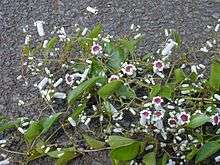Paederia foetida
Paederia foetida is a species of plant, with common names that are variations of skunkvine, stinkvine, or Chinese fever vine.[3] It is native to temperate, and tropical Asia; and has become naturalized in the Mascarenes, Melanesia, Polynesia, and the Hawaiian Islands, also found in North America by recent studies.[2]
| Skunkvine | |
|---|---|
 | |
| Scientific classification | |
| Kingdom: | |
| (unranked): | |
| (unranked): | |
| (unranked): | |
| Order: | |
| Family: | |
| Genus: | |
| Species: | P. foetida |
| Binomial name | |
| Paederia foetida | |
| Synonyms | |
| |
Paederia foetida is known for the strong, sulphurous odour exuded when its leaves or stems are crushed or bruised.[4] This is because the oil responsible for the smell, and found primarily within the leaves, contains sulphur compounds, including largely dimethyl disulphide.[5]
Distribution
P. foetida is native to Bangladesh and southern Bhutan; Cambodia; Taiwan and China (in Hong Kong and Macau, and the provinces of Anhui, Fujian, Gansu, Guangdong, Guangxi, Hainan, Henan, Hubei, Hunan, Jiangsu, Jiangxi, Shaanxi, Shandong, Shanxi, Sichuan, Xizang, Yunnan, Zhejiang); India (in Andhra Pradesh, Arunachal Pradesh, Assam, Manipur, Meghalaya, Mizoram, Nagaland, Odisha, Sikkim, Telangana, in the northern part of West Bengal, and the Andaman and Nicobar islands); Indonesia; Japan (in Honshu, Kyushu, Shikoku prefectures, as well as in the Ryukyu Islands); Laos; Malaysia; Myanmar; Nepal; the Philippines; Singapore; South Korea; Thailand; and Vietnam.[2]
Uses
It is sometimes planted as an ornamental, and has virtue in folk medicine.[2][6] It is also used as a culinary spice in some traditional cooking in North Eastern and Eastern India.
Pests and diseases
The caterpillars of four hawkmoth species are recorded to feed on P. foetida: Neogurelca hyas, Macroglossum corythus, M. pyrrhosticta and M. sitiene.[7]
References
- This species was first described botanically and published in Mantissa Plantarum 1: 52. 1767. "Name - Paederia foetida L." Tropicos. Saint Louis, Missouri: Missouri Botanical Garden. Retrieved August 9, 2010.
- "Paederia foetida". Germplasm Resources Information Network (GRIN). Agricultural Research Service (ARS), United States Department of Agriculture (USDA). Retrieved August 9, 2010.
- "Ecology of Paederia foetida". ISSG Database. Invasive Species Specialist Group (IUCN and SSC. Retrieved August 9, 2010.
- Chanda, Silpi; Sarethy, Indira P.; De, Biplab; Singh, Kuldeep (2013-12-01). "Paederia foetida — a promising ethno-medicinal tribal plant of northeastern India". Journal of Forestry Research. 24 (4): 801–808. doi:10.1007/s11676-013-0369-2. ISSN 1993-0607.
- K.C.Wong; G.L.Tan (Jan–Feb 1994). "Steam volatile constituents of the aerial parts of Paederia foetida L. (abstract)". Flavour and Fragrance Journal. Universiti Sains Malaysia, Penang, Malaysia: John Wiley & Sons, Inc. 9 (1): 25–28. doi:10.1002/ffj.2730090106.
- Chanda, Silpi; Deb, Lokesh; Tiwari, Raj Kumar; Singh, Kuldeep; Ahmad, Sayeed (2015-09-03). "Gastroprotective mechanism of Paederia foetida Linn. (Rubiaceae) – a popular edible plant used by the tribal community of North-East India". BMC Complementary and Alternative Medicine. 15 (1): 304. doi:10.1186/s12906-015-0831-0. ISSN 1472-6882. PMC 4557762. PMID 26335308.
- Robinson, Gaden S.; Ackery, Phillip R.; Kitching, Ian J.; Beccaloni, George W.; Hernández, Luis M. (2010). "HOSTS - a Database of the World's Lepidopteran Hostplants". Natural History Museum, London. Retrieved 2019-09-14.